
pexels photo 114296.jpeg
I hate to claim trailblazer status, but I think it’s only appropriate that youth of today learn about the sacrifices I made growing up as a young soccer player in the South. Recently, I took my three-year-old son to a new park, one that has a battery of swingsets, a half dozen sliding boards, and all the latest in juvenile climbing scaffolding, when I realized the most impressive thing about this park were the ball fields–green, flat, irrigated fields, meticulously lined and delineated for one singular sport, soccer.
This would have been unthinkable in a rural county decades ago, so I’d like to think that all those hours I spent picking sandspurs out of shoelaces and scraping cow manure out of soccer cleats played a small part in the progress we’ve made. And it’s not because our county was dirt poor and had little discretionary funding to spend that we lacked soccer facilities. We were the second poorest county in the state, but by golly that didn’t stop us from emptying out the government coffers on what mattered most. I think it was codified somewhere in the constitution of our county that two percent of our GDP had to be spent on the defensive line. Defense wins state championships.
At that time, the head football coach was the highest paid government employee in the whole county, and the defensive line coach was the second highest–of course, this was just base salary before all the kick-backs from the booster club. Our county was built around football, the American version with thousands of adults cheering on adolescent males on Friday nights (we only had one high school in the whole county, likely, many conjectured, so we could have the biggest possible talent pool for the football team). I have nothing against this version of football, and always enjoyed playing backyard football growing up, when my bones were pliable, but eventually after a dislocated elbow and broken collarbone, I was forced to take my talents to another supposedly safer sport.
But playing soccer in the South in those days was anything but safe; in fact, our rural Junior High Soccer League, with a meager four teams, was likely the final frontier for the worldwide game of soccer.
The Mill Hill Team was by far the most primitive and had resorted to face paint, bandanas, and war chants as their main defensive strategy. They had one player who had failed the eighth grade twice who never could grasp the rules of the game. He seemed to think you scored points by how many opposing players you bowled over. Beating the Mill Hill Team was never in question, but surviving them was.
The Peach Orchard Team was by far the best team in the league and made up mostly of children of hispanic farm workers. They were led by two outstanding players named Carlos and Paco, whose wizardry with the ball was wasted on most of the spectators watching our games, by which I mean bovines watching from the fenceline–The Peach Orchard Team’s home field was a rough and tumble hayfield bordered by a cow pasture. I sometimes wonder what happened to Carlos and Paco and hope they made it to bigger leagues, where human spectators were more appreciative of their considerable talents.
The main rivalry in the league was between the Small Town Team (population 7,000) and Big City Team (population 9,000). As Captain of the Small Town Team, I can undoubtedly say that we weren’t very good. But that didn’t stop us from thinking otherwise. When our two teams collided (and I mean that more literally than figuratively) it felt as if the whole world was watching, even if the only people in the stands were our blood relations, most of whom would have rather been watching the other football.
“Kick the ball hard,” was the general exhortation from the parental cheering section in those days, back before ritzy soccer parks full of millennial parents who could Google the rules of soccer and give more advanced encouragement.
My soccer career peaked when I was recruited, as a high schooler, to referee local parks and rec games, which meant I was given a white T-shirt that said REFEREE on the back, a whistle, and ten dollars in cash after the games. Apparently, in those days, finding adults in a rural county who actually knew the rules of soccer was not easy–not that you needed to know the rules to referee three-, four-, and five-year-olds. Mostly, you just tied their shoes and pointed them in the right direction and tried to keep their parents from fist fighting in the stands.
And that, in my opinion, is when the game of soccer peaked. Now the primitive innocence is gone. The three- and four-year-olds I see playing at the local park would run circles around my junior high team. Meanwhile, the parents are no longer invested in fist fighting in support of their offspring because they’re too busy tracking biometric data about their three-year-old’s performance. And the referees, well–they are full grown men, decked out in official referee attire, who take themselves too seriously and act as if they’re about to officiate a World Cup Game. Someone probably ought to knock them down a peg and tell them if they tried giving a red card to one of those bandana-wearing mill hill boys from my youth, they likely wouldn’t have made it out of the mill hill alive.
But those were simpler times, back when Soccer in the South was basically the Wild West.

Source link
2023-12-16 11:41:08
Karl Hoffman is a distinguished agriculturalist with over four decades of experience in sustainable farming practices. He holds a Ph.D. in Agronomy from Cornell University and has made significant contributions as a professor at Iowa State University. Hoffman’s groundbreaking research on integrated pest management and soil health has revolutionized modern agriculture. As a respected farm journalist, his column “Field Notes with Karl Hoffman” and his blog “The Modern Farmer” provide insightful, practical advice to a global audience. Hoffman’s work with the USDA and the United Nations FAO has enhanced food security worldwide. His awards include the USDA’s Distinguished Service Award and the World Food Prize, reflecting his profound impact on agriculture and sustainability.





